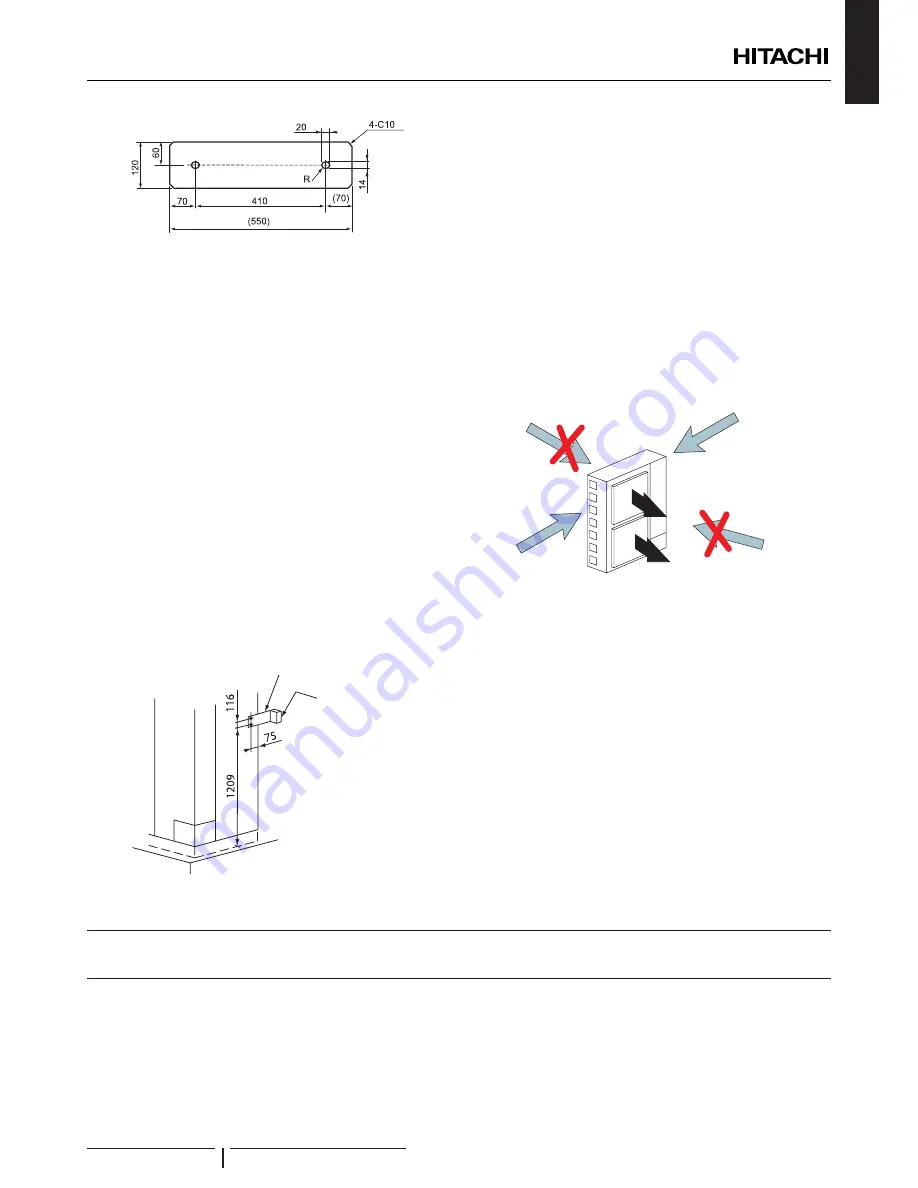
ENGLISH
• The foundation drawing shown previously is an example.
• The unit is low-vibration model, but consider using some
floor reinforcement or anti-vibration mat/rubber when
vibration should occur due to weakness of attached surface.
•
The foundation shall be unified with the floor slab. If not,
calculate the vibration proof of the installation of Yutaki M
Unit as well as of the Yutaki M Unit with the foundation in
order to ensure strength against a fall or for when the unit
has to be moved.
• Drain water and rainwater are discharged from the bottom of
the unit when in operation as well as when stopped.
• Choose a location with good drainage or place a water drain
as in the drawing.
•
Make the foundation flat and waterproof, as a water pool
may appear in case of, for instance, rain.
•
This is a low-profile product with a shallow depth. It may also
be able to fix on the wall as shown below when fixing only
with the foundation bolt does not seem sufficiently stable
depending on the conditions of the installation. (Metal fittings
must be field supplied).
Fix unit to the wall
Anti-vibration rubber
(field supplied)
Both sides can be fixed to the
wall. (Metal fittings are field
supplied)
1
Fix the unit onto the wall as indicated in the figure. (Stay field
supplied)
2
The foundation shall be strong enough to avoid any
deformation and vibration.
3
In order to prevent vibration transfer to the building, place
rubber material between the stay and the wall.
!
C A U T I O N
Pay attention to the following for installation:
• Installation shall ensure that unit will not incline, vibrate, make noise
or fall down by a blast of wind or in an earthquake. Calculate quake-
resistance strength to ensure that installation is strong enough
against falling. Fix the unit with wires (field supplied) when installing
in a location without walls or windbreak and likely exposed to a blast
of wind.
• Apply vibration-proof material where necessary.
Installing location where the unit will be
exposed to strong wind
Adverse strong wind
Air flow
Adverse strong wind
Strong winds against the unit’s air outlet causes short
circuits and these can be the consequences:
•
Lack of air flow and adversely affect to normal function.
• Frequent frost acceleration.
• Fan can rotating very fast until it breaks.
Follow the instructions below to install on a rooftop or a
location without surrounding buildings, where strong wind is
expected against the unit.
1
Choose a location where the outlet or inlet side of the
product will not be exposed to strong wind.
2
In case the fulfillment of point 1 is not possible, it is
recommended to use the optional parts.
!
C A U T I O N
Excessive strong wind against the unit outlet may cause inverse rotation
and damage the fan motor.
7 REFRIGERANT AND WATER PIPING
7.1 GENERAL NOTES BEFORE PERFORMING PIPING WORK
• Prepare locally-supplied copper pipes.
• Select the piping size with the correct thickness and correct
material able to withstand sufficient pressure.
• Select clean copper pipes. Make sure that there is no dust
or moisture inside the pipes. Blow the inside of the pipes
with oxygen free nitrogen to remove any dust and foreign
materials before connecting them.
?
N O T E
A system with no moisture or oil contamination will give maximum
performance and lifecycle compared to that of a poorly prepared system.
Take particular care to ensure that all copper piping is clean and dry
internally.
REFRIGERANT AND WATER PIPING
PMML0342B rev.1 - 03/2016
9















































